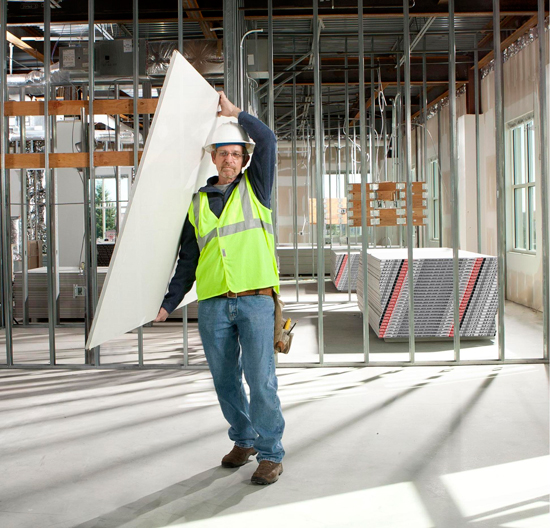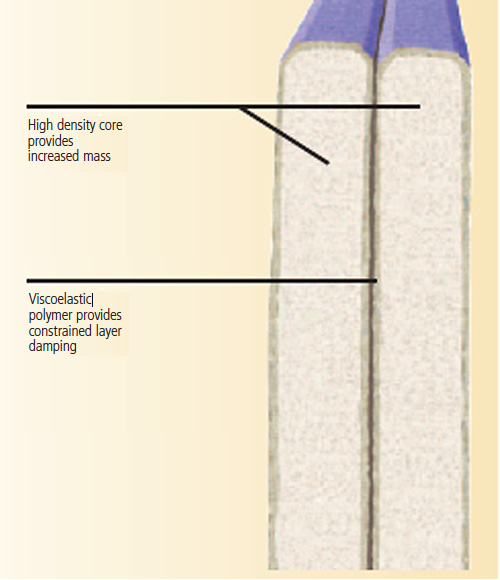Gypsum’s Role in Earning Points in LEED v4 EQ, and Other Credits
Gypsum Board Fire and Mold Resistance

Photo courtesy of National Gypsum
Gypsum board provides a barrier to fire, heat and smoke, and it resists mold and mildew.
In the past five decades, the gypsum manufacturers have worked to maximize gypsum’s inherent fire-resistant qualities. Gypsum provides a formidable barrier to fire, heat and smoke for some period of time because of its makeup: about 50 percent chemically combined water by volume and 20 percent chemically combined water by weight. As gypsum board is heated, the calcium sulphate dehydrates, pushing moisture to the surface. But after some time of high heat exposure, the board shrinks and could crack, allowing fire to penetrate, or causing ceiling-installed board to fall. The answer was the development of Type X gypsum board, a 5/8-inch-thick extra fire-resistant board that is reinforced with noncombustible fibers in the core that counter balance the shrinkage of the board when exposed to high heat.
Gypsum board companies produce mold-resistant products with chemically treated paper and core, and with fiberglass faced panels. While mold will grow anywhere —even on glass if there is a layer of dust present to serve as a food source—the strategies employed to resist mold growth on gypsum products make it a reliable material. Some gypsum board resists the growth of mold per ASTM G 21 (Standard Practice for Determining Resistance of Synthetic Polymeric Materials to Fungi) with a score of 0, the best possible score, and per ASTM D 3273 (Standard Test Method for Resistance to Growth of Mold on the Surface of Interior Coatings in an Environmental Chamber) with a score of 10, again the best possible score. Check with each manufacturer to verify the attainment of these scores.
Even so, moisture management strategies are recommended for gypsum board during construction, during occupancy and for the life of the structure.
Over the past decades, the gypsum industry has developed numerous products for simple and complex applications. These include abuse- and impact-resistant gypsum board for use in areas where surface durability and indentation, as well as moisture, mold and mildew resistance are major concerns.
In the next section, we’ll look more closely at how gypsum board’s mold-resistant and sound-dampening characteristics contribute to points in attaining LEED v4 certification.
Gypsum’s Role in LEED v4 EQ Category
Because of its inherent qualities, gypsum board can play a substantial role in earning points in LEED v4. In this section, we’ll look at the connections between the use of gypsum and these elements of LEED v4 category that deal with Indoor Environmental Quality:
• Acoustic Performance: Speech privacy and sound insulation
• Low-Emitting Materials
• Building Clearance
• IAQ Management Plans
Indoor Environmental Quality Credit: Acoustic Performance
This credit can earn points in these LEED rating systems: BD+C: New Construction (1 point), BD+C: Schools (1 point), BD+C: Data Centers (1 point), BD+C: Warehouses and Distribution Centers (1 point), BD+C: Hospitality (1 point) and BD+C: Healthcare (1-2 points).
According to the LEED Reference Guide for Building Design and Construction, there are two options to satisfy this credit:
Option 1: Speech privacy, sound isolation, and background noise (1 point)
Option 2: Acoustical finishes and site exterior noise (1 point)
Anyone who has spent time in an overly noisy indoor environment can understand the intent of this credit:
“To provide workspaces and classrooms that promote occupants’ well-being, productivity, and communications through effective acoustic design.”v
In commercial buildings, high-rise, and schools, excess sound transmission (also known as noise) has a massive impact on the comfort and health of the occupants. According to a study in 2007 by the World Health Organization’s (WHO) Noise Environmental Burden on Disease working group, increased chance of heart attack has been linked to excess noise.vi
“The new data indicate that noise pollution is causing more deaths from heart disease than was previously thought,” working group member Deepak Prasher, a professor of audiology at University College in London, said in the study.
Chronic stress is a result of noise pollution. And according to the WHO report, chronic high levels of stress hormones such as cortisol, adrenaline and noradrenaline can lead to hypertension, stroke, heart failure and immune problems.
Sound is a vibration measured in decibels. It enters buildings and rooms from many sources—building mechanicals, computers, human conversation, music, automobile traffic, sirens, aircraft, weather, televisions, video games and dogs barking.
Sound waves move easily through cavity walls, especially through interior walls that lack insulation and which are not reinforced with sound-dampening gypsum board. The term “paper-thin walls” describes not the thickness of the walls, but their composition.
The ability of a wall partition to attenuate, or block, airborne sound is measured by Sound Transmission Class, or STC. The STC rating provides an indication of how loud transmitted sound is perceived by the listener. Higher STC values are more effective for reducing sound transmission.
STC values are derived by conducting a test according to a procedure outlined in ASTM E 90 Standard Method for Laboratory Measurement of Airborne Sound Transmission Loss of Building Partitions. The test data collected is analyzed using ASTM e 413 Classification for Rating Sound Insulation and result in a single-number acoustical rating. The rating assesses the airborne sound transmission performance at a range of frequencies from 125 Hz to 4,000 Hz, which is consistent with the frequency range of speech.
Some gypsum products reduce unwanted sound transmission better than others. And the increasing awareness of noise pollution has driven the need for high rated STC wall partitions.
Sound-dampening gypsum board allows for construction of high STC wall assemblies that are thinner and cost effective. New sound-dampening gypsum board products are composed of a layer of viscoelastic damping polymer sandwiched between high-density gypsum cores encased in a heavy, abrasion and mold/mildew/moisture-resistant paper on both sides.

Image courtesy of National Gypsum
Composition of sound-dampening gypsum board.









